What is the Swing offense in basketball
The Swing offense is a basketball offensive strategy that utilizes several basketball screens alongside ball reversal action and continuity patterns to create scoring opportunities near the basket or near the perimeter.
Who developed the Swing offense
The Swing offense was developed by Bo Ryan and it helped him win more than 700 total games throughout his coaching career, including four national championships when he was the head coach at the University of Wisconsin-Platteville.
Furthermore, Coach Ryan used the concepts of his Swing offense during his time as the head coach of the University of Wisconsin men’s basketball team to achieve consecutive winning seasons as well as reaching the NCAA Division 1 Final Four in the 2013-14 season and the championship game the very next season in 2014-15.
Why is it called the Swing offense
It is called the Swing offense because the basketball will usually swing from one side of the court to the other side throughout the overall flow of offensive execution.
Essentially, the Swing offense generally emphasizes shot selection of the highest quality, preferably near the basket as well as near the perimeter, primarily by causing defensive breakdowns.
However, to produce those defensive breakdowns, the offensive team will typically have to reverse the ball (i.e. swing it) from one side to the other side, commonly more than once and that is basically the foundation of the Swing offense.
In other words, the Swing offense prioritizes ball reversal to initiate and execute its built-in continuity patterns, which then generates the best available scoring opportunity for the offensive team as a whole.
What are general benefits of the Swing offense
The general benefits of the Swing offense are that it is team-oriented, it can possibly create defensive mismatches, and it is also potentially effective for versatile teams.
Team-oriented
The Swing offense is generally team-oriented and because of that, it is usually not necessary to rely on one or two dominant scorers.
Essentially, in the Swing offense, all five players could potentially contribute as viable scoring options.
Moreover, this also means that players do not need superior talent and/or above average athletic abilities to have success over opposing teams when executing the Swing offense.
Possibly create defensive mismatches
The Swing offense could possibly create defensive mismatches, primarily because of the screening actions. Basically, defensive teams will sometimes implement the switching tactic as a counter to basketball screens.
The usual problem, though, is that this could produce situations in which defensive players are not matched up equally with offensive players.
That is to say, defensive post players could potentially be matched up with offensive perimeter players and/or defensive perimeter players could match up with offensive post players.
If that occurs, it is more or less a defensive breakdown. Therefore, the offensive team could feasibly take advantage of it and generate a high quality shot.
Potentially effective for versatile teams
The Swing offense is potentially effective for versatile teams, mainly because each player could have the opportunity to transfer into a new role within the overall offensive flow.
So, if multiple players already possess the foundational basketball skills of passing, cutting, screening, and shooting, then this could be very favorable for an offensive team in general.
Furthermore, this is also beneficial if offensive players possess additional abilities that are not usually defined within their standard basketball positions and at the same time, the opposing team is not prepared to defend outside of their normal areas.
For example, let’s say an offensive point guard knows how to score via low post moves and then receives the ball near the low post area.
When that occurs, the defensive point guard that is presumably assigned to that same offensive point guard may not know how to properly defend against low post action.
As a result, this could lead to the offensive point guard scoring near the basket and/or the defensive point guard committing undesirable fouls.
What are notable downsides of the Swing offense
The notable downsides of the Swing offense are that it is potentially ineffective for non-versatile teams and it is probably not necessary if a team already has multiple talented players, particularly with above average skills and/or athleticism.
Potentially ineffective for non-versatile teams
The Swing offense is potentially ineffective for non-versatile teams in general. Basically, perimeter players will eventually have to move to the low post area and at the same time, low post players will inevitably be required to move towards the perimeter.
What this essentially means is that if perimeter players such as a point guard or shooting guard are not very comfortable playing in the low post area and/or a low post player such as a center is severely limited when playing near the perimeter areas (i.e. a non-shooter), then the Swing offense may not be too useful in those instances.
Probably unnecessary if there is an abundance of talent
The Swing offense is probably unnecessary if a team has an abundance of talented players. In other words, if a team possesses multiple players that can score efficiently and effectively due to their individual skill, athleticism, and overall talent, then the Swing offense may not be needed for the team to be successful.
Furthermore, in that instance, the foundational concepts of the Swing offense in terms of passing the ball various times and/or executing the continuity patterns over and over to produce the best available shot might actually limit players with above average scoring ability and/or superior talent in an unnecessary manner.
Affiliate Disclosure: I may earn a commission on qualifying purchases made through the links below.
What is an example of a full court initial formation for the Swing offense
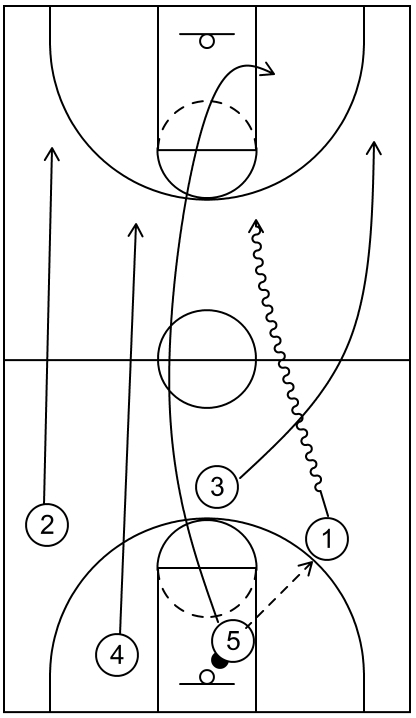
This is an example of an initial formation for the Swing offense during a full court transition. Moreover, this example diagram as well as many other diagrams below are derived from insights within The Complete Guide to Bo Ryan’s Swing Offense & Offensive System.
The Swing offense begins after the opposing team makes or misses a shot. In the example diagram above, the point guard, indicated as player 1, receives the ball from player 5 after the opposing team misses a shot.
Following that, the point guard dribbles the ball down the court to fill the right side slot area. As a side note, the slot area is also referred to as the lane line extended area, particularly within the Swing offense.
The shooting guard, indicated as player 2, sprints down the court to fill the left side wing, near free throw line extended, usually a step or two behind the three-point line.
The small forward, indicated as player 3, sprints down the court to fill the right side wing, near free throw line extended, usually a step or two behind the three-point line.
The power forward, indicated as player 4, generally trails behind the first three players, and then fills the left slot area opposite the point guard.
The center, indicated as player 5, usually trails behind the other four players, and then fills slightly above the strong side low post block.
It should also be noted that in the Swing offense, player 4 and player 5 are the primary defensive rebounders and they will trail behind player 1, player 2, and player 3 most of the time.
Moreover, these initial positions are not automatically set in stone. In other words, there may be certain occasions in which player 4 could start at the low post block while player 5 could start in the slot.
Also, there could also be an instance in which player 1, the typical point guard, cannot receive the ball to initiate the offense.
For example, during the transition defense phase, a defender that is assigned to player 1 could implement the denial defense tactic.
If that is the case, then it is permissible for player 2 or player 3 to become the play initiator as opposed to receiving an unnecessary five-second violation during the inbound phase.
Afterwards, player 2 or player 3 (whichever one received the ball via the inbound pass) would dribble towards the right side slot while player 1 would fill either the left side wing or right side wing.
This is logical because each of the five players would rotate to a new area within the overall execution of the Swing offense sooner or later.
What is an example of a half court initial formation for the Swing offense
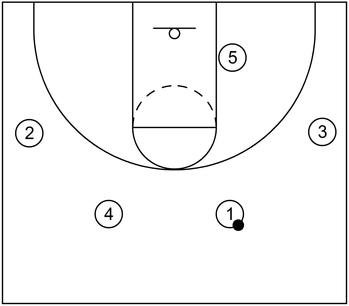
This is an example of the initial formation for the Swing offense in a half court setting which also showcases a 4 out 1 in alignment.
Furthermore, each of the offensive players are at least 12 to 15 feet from each other which also demonstrates good spacing, a fundamental concept within basketball offense execution.
What is the ball side triangle within the Swing offense
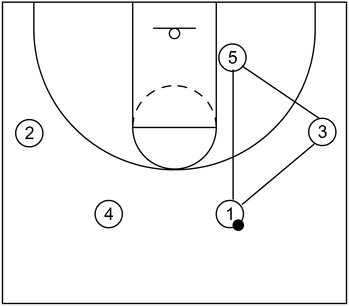
The ball side triangle is a fundamental concept within the Swing offense in which the offensive players on the strong side of the ball form a triangle between the slot, wing, and low post.
Basically, the ball side triangle could be considered an indicator which tells the offensive players that whatever side the ball is on, three players should eventually be on that same side in the slot, wing, and low post.
What are the basic rules for players within the Swing offense
The basic rules for players within the Swing offense are to generally pass the ball, cut to the basket or cut away from the ball, and/or screen for a teammate.
Moreover, these rules will typically depend on the location of the ball as well as the area of the court that an offensive player currently occupies.
Pass the ball initially to the low post player from the strong side slot
When the ball is in the strong side slot during the initial phase of the Swing offense, the offensive player with the ball should first try to pass it to the post player if that is feasible.
Following that, the post player could then attempt to score near the basket with a low post move.
Pass the ball to the strong side wing from the strong side slot
If the offensive player in the slot is not able to pass the ball to the post player, then that same player should instead pass it to the player on the strong side wing.
This type of pass is also referred to as a slot to wing pass. Also, it should be noted that during the slot to wing pass, the two players on the weak side of the floor should interchange positions with shallow cuts to discourage potential help defense from that same weak side.
Moreover, if a weak side defender does decide to help against the strong side action, then the offensive player with the ball could execute a skip pass for one of the weak side offensive players, which could lead to a potential jump shot, especially from three-point range.
It is also noteworthy to mention that Coach Bo Ryan said that when the weak side players execute the shallow cuts, they should always look at the ball and be ready to receive it for a possible jump shot via the skip pass if necessary.
In addition to that, when the ball is on the strong side wing, the offensive player with the ball should look inside to the low post player for about a second or two if that is a viable option as well.
Pass, cut, or screen when the ball is on the strong side wing
If the offensive player with the ball on the wing cannot get it to the low post player, then this automatically triggers action that is derived from the UCLA offense.
That is to say, the slot player on the strong side will execute a UCLA cut to the basket via the path of least resistance by the defender. In other words, the UCLA cut will either occur on the side of the ball or on the opposite side away from the ball.
As an example, if the slot defender jumps to the ball upon the initial slot to wing pass, then the UCLA cut would most likely occur on the opposite side away from the ball.
Furthermore, at the same time, the post player will cut up to the strong side high post elbow to execute a UCLA back screen, which is also referred to as an up screen within the Swing offense.
Following the UCLA action, the offensive player with the ball on the wing can pass it to the cutter near the basket in the lane if that is open.
Fill the slot and the low post block on the strong side after UCLA action
If the player with the ball near the strong side wing did not pass it to the cutting player, then that same cutting player should fill the strong side low post area while the screener fills the vacated strong side slot after the UCLA action occurs.
From there, the offensive player with the ball could look inside to the player that cut to the basket for an additional post up opportunity if that is viable.
Pass the ball to the strong side slot from the strong side wing
If the cutting player that filled the strong side low post does not receive the ball, then the strong side wing player in possession of the ball should pass it to the player that filled the strong side slot area.
Next, if the player that receives the ball in the strong slot is open, that same player is permitted to take the open three-point shot, if they have the ability to do so.
Set a flare screen on the weak side with a possible skip pass on the strong side
As the offensive player in the strong side slot receives the ball, the weak side wing player should set a flare screen, also known as a fade screen within the Swing offense, for the weak side slot player.
Afterwards, the weak side slot player would fill the weak side wing while the screener fills the weak side slot.
Also, following the flare screen action, the strong side slot player with the ball could execute a skip pass to the weak side wing player for a possible jump shot if that is open.
Screen and cut on the new weak side
If the weak side wing player does not receives the ball after the flare screen action, then the strong side slot player with the ball should pass it to the other slot player. This is also known as a slot to slot pass.
At this point, the ball changed sides of the court and when that occurs, it automatically triggers screen and cut action on the new weak side of the court.
It should also be stated that even if the initial weak side wing player received the ball but did not take the shot after the flare screen action, that would also trigger the screen and cut action on the new weak side because once more, the ball changed sides of the court.
Next, the low post player on the current weak side will set an angled back screen about a step or two away from the post block for the new weak side wing player.
Afterwards, that same weak side wing player will cut to the basket via the path of least resistance and then possibly receive the ball from the strong side slot player (or strong side wing player in some instances).
From there, the weak side wing player could possibly score at the rim if it is feasible to do so.
On the other hand, if the weak side wing cutter does not receive the ball, then that same cutter will continue through to the low post block on the same side of the ball while the screener fills the vacant weak side wing area.
Initiate the continuity pattern of the offense
At this point, there would be three players on the strong side of the court; one player in the slot, one player on the wing, and one player in the low post.
As mention earlier, these three players would create the ball side triangle and there is also the other two players on the weak side of the court as well.
So, it is now possible to execute the continuity pattern of the Swing offense with the same passing, cutting, and screening actions as before. However, this time, those actions would occur on the opposite side of the court.
What are examples of basic scoring options within the Swing offense
These are examples of basic scoring options within the Swing offense, which are also primarily used against man to man defense.
Part 1

This is the beginning of the Swing offense during the initial half court phase after transition occurs. To start, 5 could receive the ball from 1 and then quickly score via a low post move if that is possible.
If 5 does not receive the ball from 1, then 3 could receive it instead. As that slot to wing pass occurs, 2 and 4 could interchange on the weak side with shallow cuts.
Also, at the same time, 5 could receive the ball from 3 if possible and attempt to score near the low post area.
Part 2

If 5 does not receive the ball from 3, then this triggers the UCLA action. For this diagram example, 1 cuts on the opposite side of the ball to the basket via the UCLA screen set by 5.
Next, 1 could receive the ball from 3 and score at the basket. Otherwise, 1 could fill the right side low post area. Afterwards, 1 could receive the ball from 3 and score in the low post if that is feasible.
Moreover, as that action happens, 5 fills the vacant right side slot after the UCLA screening action.
Part 3

From that point, if 1 did not receive the ball, then 5 could receive it instead from 3. Following that, 2 could cut back towards the left side wing area via the flare screen set by 4.
Next, 2 could receive the ball from 5 via a skip pass and take the open jump shot.
Part 4
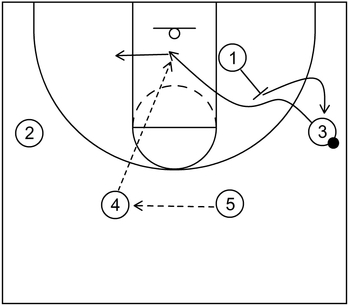
If 2 is not open to receive the ball via the skip pass, then 4 could receive it instead from 5.
At this point, the ball has changed sides of the court. This triggers a basket cut by 3 via an angled back screen set by 1.
Afterwards, 3 could receive the ball from 4 and score at the rim if that is open. Otherwise, if it is not open, then 3 continues the cut through to the left side low post area while 1 fills the empty right side wing area.
Part 5

Now, a ball side triangle occurs once again, but this time, on the left side of the court. This also initiates the continuity action of the Swing offense.
So, 2 could receive the ball from 4 while 1 and 5 interchange with shallow cuts. Additionally, 3 could receive the ball from 2 and attempt to score with a low post move if that is suitable.
Part 6
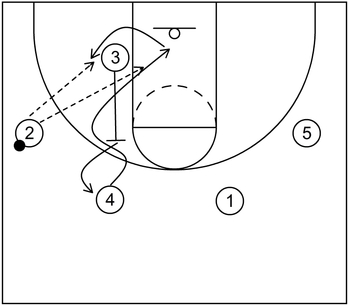
If 3 does not receive the ball from 2, then this triggers the UCLA action. For this diagram example, 4 cuts on the same side of the ball to the basket by way of the UCLA screen set by 3.
Next, 4 could receive the ball from 2 and score at the rim if open. Otherwise, 4 could cut back to the left side low post block while 3 fills the left slot area.
From there, 4 has another opportunity to receive the ball from 2 in the low post and could score if it is possible.
Part 7
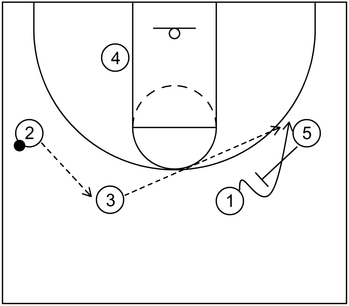
If 4 does not receive the ball, then 3 could receive it instead from 2. After that, 1 could cut to the right side wing via the flare screen set by 5.
Next, 1 could receive the ball from 3 via the skip pass and take the open jump shot, particularly from three-point range.
Part 8

For this example, 1 received the ball from 3 via the skip pass but 1 did not take the jump shot. When that occurs, the ball still changed sides of the court which triggers the basket cut by 2 and angled back screen by 4.
Following that, 2 could receive the ball from 1 and score near the rim. If that is not available, then 2 would continue to the right side low post area while 4 fills the left side wing area.
From this point, there is a ball side triangle once again on the right side of the court. The primary difference is that the ball is already on the wing as opposed to being in the right slot as earlier.
Therefore, 2 could receive the ball from 1 and score with a low post move if that is available. If that is not possible, then 5 would receive the ball from 1 which would also trigger the flare screen continuity action between 3 and 4 and so on.
What are examples of scoring variations within the Swing offense
These are examples of scoring variations within the Swing offense which could primarily be utilized as counters to certain defensive actions.
Example 1
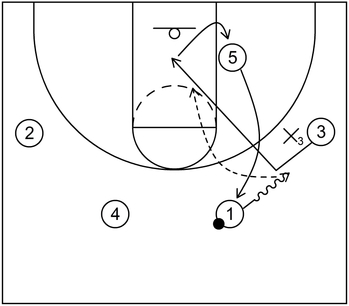
This is an example of a scoring variation within the Swing offense in which X3 denies the slot to wing pass.
When that occurs, 1 could dribble at 3 which then triggers an automatic backdoor cut to the basket by 3. Following that, 3 could receive the ball from 1 and score at the rim.
If 3 does not receive the ball, then 1 would continue the dribble to the right side wing while 5 fills the vacant right side slot. Also, 3 would fill the empty right side low post area to complete the ball side triangle.
From that point, the team could continue to execute the basic options of the Swing offense.
Example 2 – Part 1
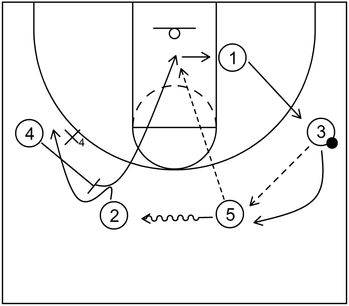
This is an example of a scoring variation in which X4 attempts to hinder the effectiveness of the flare screen by switching onto 2 after 5 receives the wing to slot pass from 3.
This basically means that 2 is not open to receive the ball from 5. However, as a counter, 4 could slip to the basket, receive the ball from 5 instead, and score at the rim.
If 4 does not receive the ball after the slip screen, then 5 could dribble across to the left side slot. At the same time, 3 could fill the vacant right side slot while 1 fills the empty right side wing and 4 fills the right side low post area.
Example 2 – Part 2
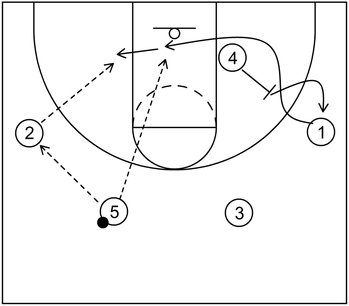
Next, because the ball changed sides via the dribble action of 5, this triggers the cut to the basket by 1 as well as the angled back screen by 4.
After that, 1 could receive the ball from 5 and score at the rim. If that is not available, then 1 cuts through to the left side low post block while 4 fills the right side wing area.
Following that, the Swing offense would continue in which 2 receives the ball from 5 and then 1 could receive the ball from 2. If those scoring options are not practical, then the UCLA action would happen and so forth.
Example 3
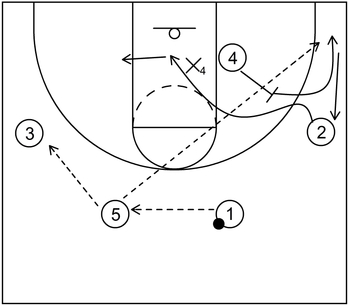
This is an example of a scoring variation in which X4 attempts to mitigate the effectiveness of the angled back screen by switching onto 2 after 5 receives the slot to slot pass from 1.
To counter against that switching tactic, 4 could pop away to the right side corner, receive the ball from 5 via the skip pass, and then take the jump shot if open.
If 4 does not receive the ball, then the players could continue to execute the Swing offense as usual.
So, 4 would lift up to the right side wing area, 2 would cut through to the left side low post area, and 3 would receive the ball from 5.
From there, 2 could possibly receive the ball from 3 or trigger the UCLA action and so forth.
What are examples of quick hitters within the Swing offense
Example 1 – Part 1
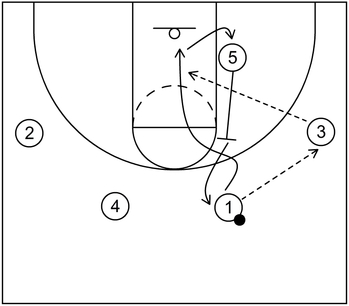
This is an example of a quick hitter within the Swing offense which primarily utilizes stagger screens to create a scoring opportunity for the team’s best shooters.
To begin, 3 receives the ball from 1 and then 1 cuts to the basket via the UCLA screen set by 5. From there, 1 could receive the ball from 3 and score near the rim if that is open.
If it is not open, then 1 would fill the right side low post area while 5 fills the right side slot.
Example 1 – Part 2
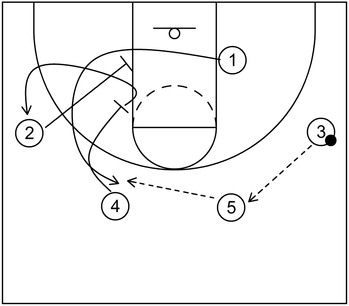
Next, 5 receives the ball from 3 and as that occurs, 1 could cut to the left slot via the stagger screen set by 2 and 4.
Additionally, 4 could cut to the left side wing area after setting the screen. Following that, 1 could receive the ball from 5 and take the three-point shot if open.
Example 1 – Part 3
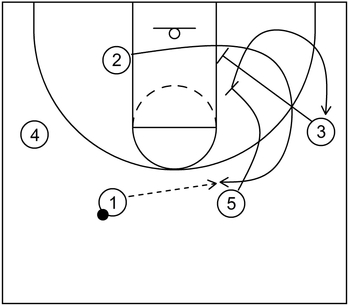
If 1 is not open after receiving the ball from 5, then 2 could cut to the right side slot via the stagger screen set by 3 and 5. Afterwards, 2 could receive the ball from 1 and take the open jump shot.
Furthermore, if 2 receives the ball but the jump shot is not available, then 5 could fill the right side wing area and 3 could fill the right side low post area as well. From that point, the team could implement the basic options of the Swing offense.
Example 2 – Part 1
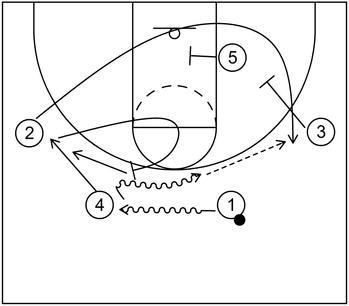
This is an example of a quick hitter within the Swing offense which utilizes various basketball screens to produce scoring opportunities near the rim or perimeter.
To start, 1 dribbles toward the left slot area. This would normally trigger an angled back screen but for this example, 4 cuts towards the left side wing instead.
As 4 reaches the wing area, 2 cuts toward the right side wing area via a stagger screen set by 3 and 5. Also, at the same time, 4 executes a shallow cut but immediately turns around to set an on-ball screen.
1 dribbles to the top via the ball screen set by 4 and as that occurs, 4 pops back towards the left side wing. Following that, 2 could receive the ball from 1 and take the three-point shot if open.
Example 2 – Part 2

If 2 is not open to receive the ball, then 4 would receive it from 1 instead. Next, screen the screener action would occur in which 3 would cut to the basket via an angled back screen set by 5.
From there, 3 could receive the ball from 4 and score at the rim. If 3 is not open to receive the ball, then 3 would fill the empty low post area on the left side.
In addition to that, 1 would fill the left slot, 2 would fill the right slot, and 5 would fill the right side wing area.
At that point, there is a ball side triangle so the players could execute the basic options of the Swing offense.
Example 3
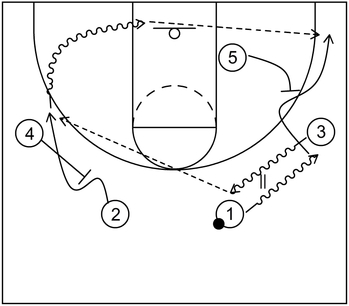
This is an example of a quick hitter within the Swing offense that could generate a pair of three-point shots, particularly during the end of a quarter or other late game situation when the team needs a three.
To begin, 1 dribbles toward the right side wing to execute a dribble handoff with 3. As that handoff action occurs, 2 cuts to the left side wing via a flare screen set by 4.
Next, 2 receives the ball from 3 via a skip pass. If that is open, then 2 could take the three-point shot. Otherwise, 2 could then dribble drive towards the baseline.
As that dribble drive action happens, 1 could cut to the right side corner via the hammer screen set by 5.
Following that, 1 could receive the ball from 2 via the drift pass and then take the three-point shot if open.
What are examples of simple breakdown drills for the Swing offense
These simple examples are derived from insights of Breakdown Drills for Swing Offense by Ryan Looney.
Example 1
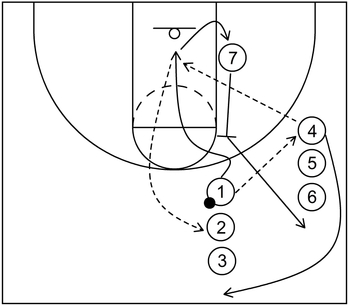
This breakdown drill primarily focuses on the UCLA actions which include cutting and screening. To quickly set up the drill, there will be two separate lines near the right slot area and right side wing respectively. Furthermore, one player will fill the right side low post area.
To begin, 4 receives the ball from 1 and immediately after that, 1 cuts to the basket via the UCLA screen set by 7. Next, 1 receives the ball from 4 and scores at the rim with a layup.
Afterwards, 1 gets the ball out of the net and then 2 receives the ball from 1. Also, 1 then fills the right side low post area.
At the same time, 4 cuts to the back of the line near the right slot while 7 cuts to the back of the line near the right side wing. To continue the drill, 5 would receive the ball from 2 and so forth.
Example 2

This breakdown drill mainly emphasizes the wing cutting action and angled back screen. To set up the drill, there are two separate lines near the left slot area and right side wing. Additionally, one player fills the right side low post area.
To begin, 4 receives the ball from 1 via a skip pass. After that, 1 cuts to the basket via the angled back screen set by 7. Next, 1 receives the ball from 4 and scores at the rim with a layup.
Following that, 1 gets the ball out of the net and then 2 receives the ball from 1. Moreover, 1 fills the right side low post area.
As that happens, 4 cuts to the back of the line near the right side wing while 7 cuts to the back of the line near the left slot area. From there, 5 would receive the skip pass from 2 and so on.